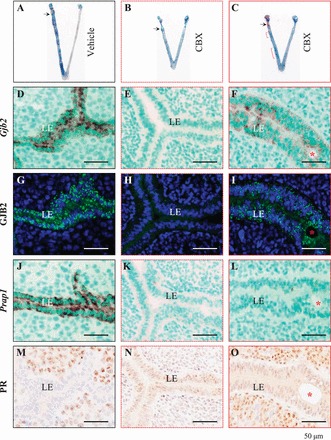FIG. 4.

Effects of CBX on artificial decidualization and uterine gene expression detected on Pseudopregnant Day 4.5. Artificial decidualization (indicated by blue segments) was induced by oil infusion of the left uterine horn of pseudopregnant mice. The injection site for oil infusion is indicated by a black arrow on uterine images in A–C. Fresh frozen longitudinal uterine sections (D–O) were cut in the orientation of mesometrial and antimesometrial. Serial sections from a blue segment (indicating decidualization) of each uterus (except B) in A–C are lined under the same column with the same outline (solid black from A, dotted red from B, solid red from C). A) Vehicle treated. B) CBX treated, representing the most suppressed decidualization upon CBX treatment, with shortened appearance. C) CBX treated, representing the least effect of CBX treatment, with shortened appearance; red bracket, suppressed decidualization. D–F) In situ hybridization detection of Gjb2 mRNA in vehicle (D) and CBX-treated (E and F) uteri. G–I) Immunofluorescence detection of GJB2 protein in vehicle (G) and CBX-treated (H and I) uteri. J–L) In situ hybridization detection of proline-rich acidic protein 1 (PRAP1) mRNA in vehicle (J) and CBX-treated (K and L) uteri. M–O) Immunohistochemistry detection of PR protein in vehicle (M) and CBX-treated (N and O) uteri. Red star, infused oil droplet. Bar = 50 μm.
